All over the world there have been in service about 20 tranporter bridges. On this page you will find a surveay of the transporter bridges which have been in service once, but that have been abandoned today (the actual transporter bridges you can find under the menu item "actual transporter bridges").
| Place | Year built | Closure | Removal | Length |
|---|---|---|---|---|
| Kiel (Du) | 1910 | 1923 | 1923 | 128 m |
| Runcorn (GB) | 1905 | 1961 | 1961 | 304 m |
| Rouen (Fr) | 1899 | 1940 | 1940 | 142 m |
| Nantes (Fr) | 1903 | 1955 | 1958 | 141 m |
| Marseille (Fr) | 1905 | 1944 | 1945 | 165 m |
| Brest (Fr) | 1909 | 1944 | 1947 | 109 m |
| Bordeaux (Fr) | 1910 | 1942 | 1942 | 426 m |
| Bizerta (Tun) | 1898 | 1909 | 1909 | 109 m |
| Rio de Janeiro (Bras) | 1915 | 1935 | 1935 | 171 m |
| Duluth (USA) | 1905 | 1929 | (hefbrug) | 120 m |
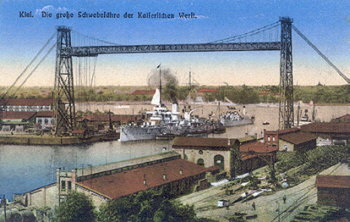
Kiel is a seaport located in Germany on the Baltic Sea. Around the year 1900 the city faced significant urban expansion and the establishment of a shipyard on the eastern shore of the port city. Associated with improved access to these Shipyards there was decided to build a transporter bridge, which opened in 1910.
The bridge was only in use until 1923. Following the closure, the transporter bridge was demolished. Today nothing can be found about this construction.
| Opening | 1910 |
| Closure | 1923 |
| Removal | 1923 |
| Distance between shores | 128 meter |
| Total length | . meter |
| Clearance | . meter |
| Motor power | . pk |
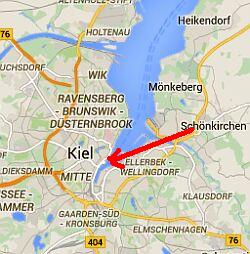
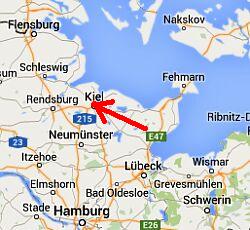
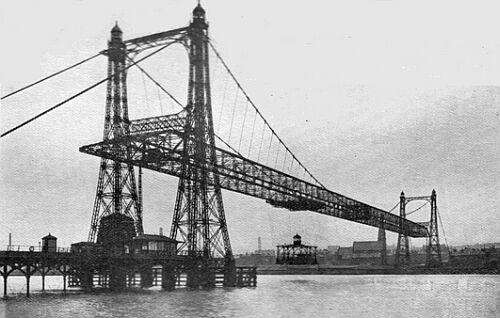
Runcorn is located on the south bank of the River Mersey. Where the river flows into the Atlantic (near the city of Liverpool) it forms a broad inlet, which in Runcorn is not too wide.
The transporter bridge between Runcorn and Widnes was built in 1905 and is the first of such a construction in England. At the time of the construction a railway bridge already existed just next to the place. On the railway bridge there was also a footpath. But for trucks and cars, there was no connection. Plans were made, a society was formed, which would do research. At first it was considered to build a normal bridge. But, given the height and length this would be too expensive. A transporter bridge can be built lighter, there are no ramps needed, so it is less expensive. In view of the good experiences with the transporter bridges in Bilbao and Rouen, people decided to also build a transporter bridge in Runcorn. Construction began in 1901, and in 1905 the bridge was put into operation.
The operation of the transporter bridge was not profitable. The company that was involved in the construction could not hold, and sold itself in spring 1911 to another company.
Over the years the number of cars rose considerably, so that the transporter bridge formed more and more a bottleneck. In addition, the technical condition of the bridge was bad. In 1961 the transporter bridge was replaced by a high bridge, just besides the location. After that, the transporter bridge was demolished. Today only the foundations on both sides of the river and the machine house in Widnes (on the north shore) are still recognizable in the landscape.
| Opening | 1905 |
| Closure | 1961 |
| Removal | 1961 |
| Distance between shores | 304 meter |
| Total length | . meter |
| Clearance | 25 meter |
| Motor power | . pk |
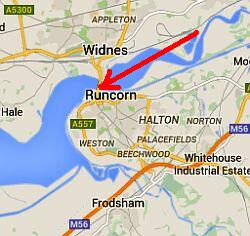
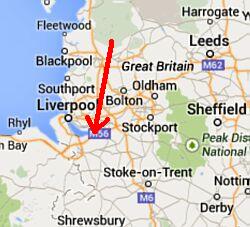
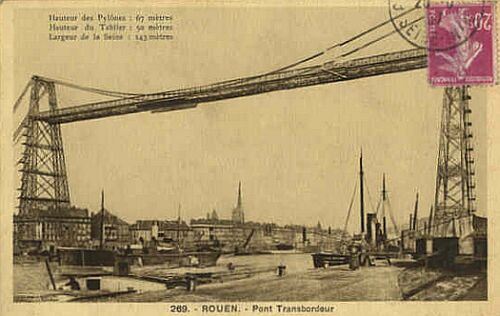
Rouen is located in France on the river Seine. As the only city of any of the transporter bridges, the town is not located on the sea. The distance to the sea is in a straight line at least 70 kilometers. In spite of that, the transporter bridge in this city was until 1940 the westernmost connection over the Seine.
Already in 1895 the city decided to build a transporter bridge to improve the connection between north and south of the city. The choice of an aerial was motivated by the fact that navigation on the river at that time consisted of sailing ships, which are obviously needed a big clearance. In 1897 work on the construction started, and it was after two years that the bridge was inaugurated in 1899. In commissioning this bridge it was the first to use electric motors for propulsion.
The platform of the bridge consisted of 130 square meters. In the middle there was a roadway for vehicles. On the one side there was a first class section, covered and equipped with chairs. On the other hand, there was a second class compartment for standing passengers only with a simple roof as cover.
With the exception of a maintenance period of a few years (1926-1930), the transporter bridge was in use until World War II. By retreating French troops the bridge was blown up on 9 June. This happened so unexpected, that a boat width refugees just sailing underneath was hit after what the boat sank.
| Opening | 1899 |
| Closure | 1940 |
| Removal | 1940 |
| Distance between shores | 143 meter |
| Total length | . meter |
| Clearance | 51 meter |
| Motor power | . pk |
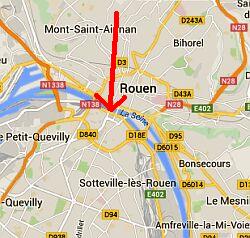
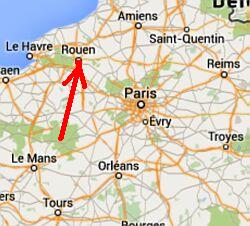
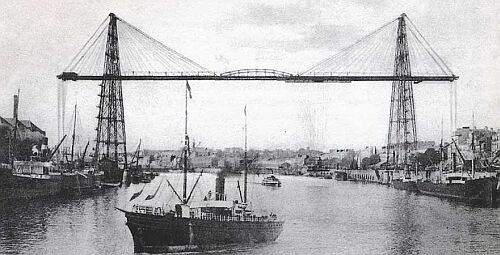
The city of Nantes is located in France on the Loire River, about 50 kilometers removed from the mouth of this river in the Atlantic. Because of the good navigability of the river (large) seagoing vessels can sail up the river to pass by the city.
The city is situated on the north bank of the river. Shipyards and factories were built on the south bank. For the transportation of the workers there was a need for a good connection. Plans existed to make a normal bridge which could be opened. But that gave too many problems with the flow of the river and it was not suitable to be passed by large ships. A tunnel was rejected. Given the good experiences with the transporter bridge in Bilbao (Sp) it was decided to build an such a transporter bridge.
In 1902 work on the construction started. On both sides a self-standing structure was established, which was anchored by cables. Between these two parts, a pre-built bridge was placed. On November 1, 1903 the transporter bridge was put into use.
The transporter bridge has survived both world wars without damage. In 1955 the operation stopped, and in the year 1958, despite protests from the population, the bridge was demolished. In the same place today we can find a modern road bridge. Just right next to this bridge we can still see remnants of the foundation of the transporter bridge.
| Opening | 1903 |
| Closure | 1955 |
| Removal | 1958 |
| Distance between shores | 141 meter |
| Total length | . meter |
| Clearance | 50 meter |
| Motor power | . pk |
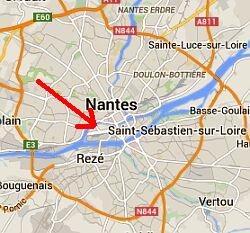
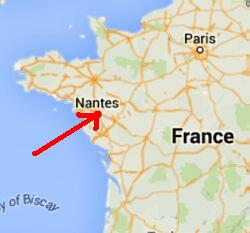
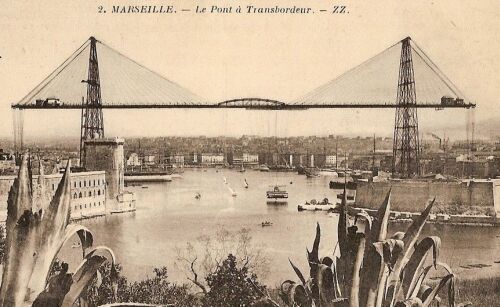
Marseille is located in France on the Mediterranean Sea. The port of the city divides the center into two parts. In 1905, an transporter bridge on entrance of the port was inaugurated.
In the thirties there was too little money to keep the bridge to use, and it was taken out of service.
During the liberation by the Allies in August 1944, the fleeing German troops blew up the bridge. The northern tower collapsed and fell into the water. The rest of the construction was blown up in September 1945 by the French.
| Opening | 1905 |
| Closure | 1944 |
| Removal | 1945 |
| Distance between shores | 165 meter |
| Total length | . meter |
| Clearance | 50 meter |
| Motor power | . pk |
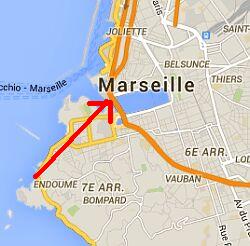
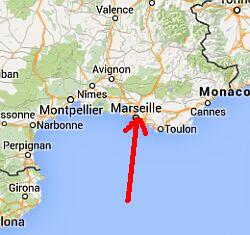
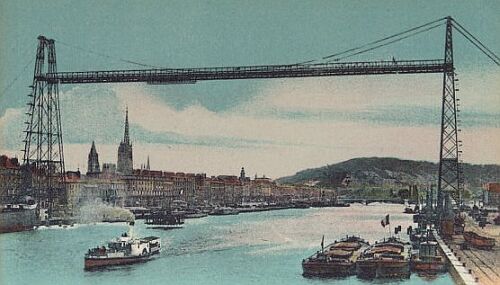
The city of Brest is located in Brittany, at the extreme western end of France at the Atlantic Ocean. Through the city flows the river La Penfeld where a naval port was located. For a good connection of the city with the western parts of the country, there was sought for a solution at the turn of the century.
In 1898 in the Tunisian city of Bizerte (Tunisia was a French colony) a transporter bridge was built. That bridge was not used very much.
In 1909 it was decided to break down the transporter bridge in Bizerte, and to rebuild it in Brest.
During the liberation actions in World War II the transporter bridge of Brest was heavily damaged. A few years later it was decided not to rebuild the bridge, but to replace it by a fixed, high-altitude, bridge.
| Opening | 1909 |
| Closure | 144 |
| Removal | 1947 |
| Distance between shores | 109 meter |
| Total length | . meter |
| Clearance | . meter |
| Motor power | . pk |
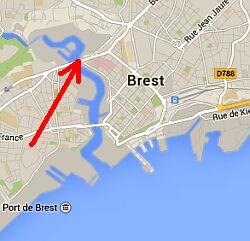
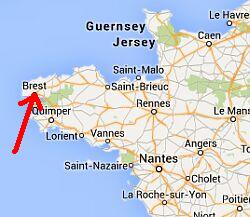
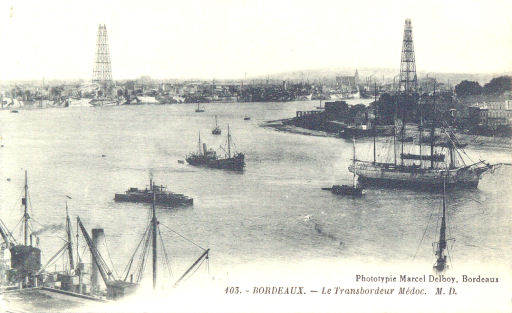
The city of Bordeaux is located on the Garonne River, which flows northwest of the city into the Atlantic Ocean. Just after the turn of the century there was a need in the north side of town for a good connection between the eastern and western districts. Following previously built transporter bridges in several French cities it was decided to build a same sort.
Given the width of the river, there was a need for a pretty big construction. The towers were 95 meters high, the length was 426. Given that length it should be the largest span in the world.
Construction began in 1910. The foundations were laid, on which the high iron portals were founded. It was expected that the building in two and a half years would be ready. But then the outbreak of the First World War gave for France other priorities, and the construction of the transporter bridge in Bordeaux was delayed. And shortly after the First World War the situation like this was continued. Lack of iron, manpower and money resulted in the fact that there the bridge was not built further on.
Ultimately nothing more happened with the bridge. The two portals were built, continued to stand in the city, without the urge to build a horizontal connection between these. In the beginning of World War II it was decided to demolish the two portals. What remains are two blocks of the foundation. They can be seen on about the same place where there is nowadays a modern lifting bridge.
| Begin bouw | 1910 |
| Closure | 1942 |
| Distance between shores | ? meter |
| Total length | 426 meter |
| Clearance | . meter |
| Motor power | n.v.t. |
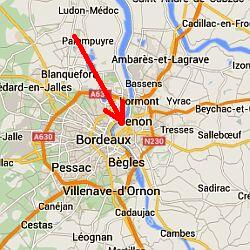
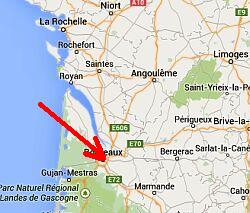
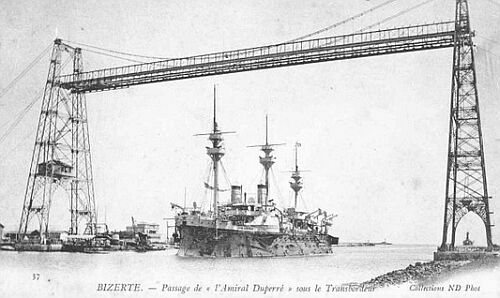
Bizerte is located in the extreme north of Tunisia on the Mediterranean coast. In Bizerte is a narrow passage to a bay about 15 km long, the Lake Bizerte.
Tunisia was around the year 1900 a French colony. In the city there was situated a French naval base, located on the south side of the bay. Since the city was located on the north side, it was therefore necessary to create a good connection over the bay.
Following the transporter bridge Rochefort (Fr) that was built around that time in France, the French constructed a transporter bridge in Bizerte in 1898. The size of the platform of the transporter bridge was 10x7 meters. Propulsion (in Bizerte) was done by a steam engine.
The transporter bridge has not long been in Bizerte. There was made not much use of it, and it was decided that it was cheaper to maintain the connection over the bay by a ferry. On the same time the which of the city of Brest was to make a connection over an estuary in that city. About nine years after the building in Bizerta, the construction was broken down and rebuilt in the French city of Brest.
| Opening | 1898 |
| Closure | 1909 |
| Removal | 1909 |
| Distance between shores | 109 meter |
| Total length | . meter |
| Clearance | 47 meter |
| Motor power | . pk |
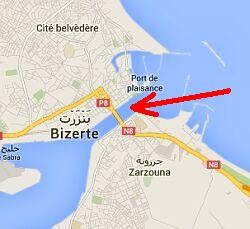
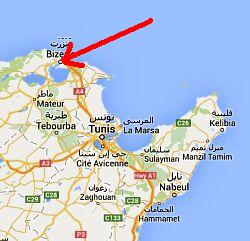
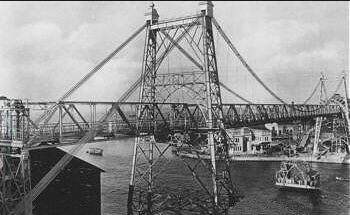
Rio de Janeiro is located in Brasil on the Atlantic Ocean. In Rio de Janeiro there is a narrow passage to the Baia de Guanabara. Near the town there is an island (about one square kilometer), the Ilha das Cobras (snake island). On this island was established the central hospital of the Brazilian Navy established.
To provide easy access to this island, a transporter bridge as made in 1915. It could carry up to 400 people simultaneously.
At a conversion and extension of the naval depot on the island the transporter bridge was no more sufficient; the capacity would be too small. Therefore, a new bridge was built from 1930, which was taken into use in 1935. In the same year the transporter bridge has been replaced by a fixed bridge.
| Opening | 1915 |
| Closure | 1935 |
| Removal | 1935 |
| Distance between shores | 171 meter |
| Total length | 288 meter |
| Clearance | . meter |
| Motor power | . pk |
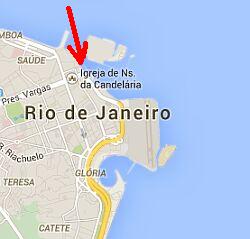
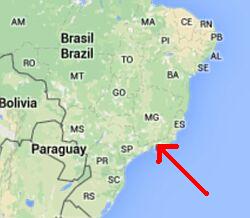
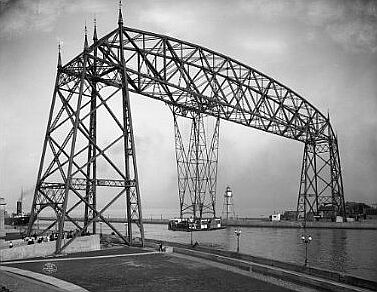
Duluth is located in the north of the USA in the state of Minnesota. The St. Louis River flows into Lake Superior, one of the lakes that form the border between the USA and Canada. Although Duluth is located on the lake and on the river, the river first passes the city, then flows 11 km south east to end in the lake. Between river and lake there is a long sandbank, where in 1900 the first buildings were created.
For the connection of the city with this area there had to be a connection. A ferry was not really qualified as the lake and river in the winter can be frozenfor a long-lasting time. The city decided to build a transporter bridge, which was opened in 1905. The platform was connected to the bridge by a steel construction. On this platform there was room for 350 people as well as some cars.
In the years to come, the capacity of the transporter bridge appeared to come short. In 1929, therefore, the transporter bridge was replaced by a large lifting bridge of 120 meters, which could be hung on the structures of the transporter bridge.
| Opening | 1905 |
| Closure | 1929 |
| Removal | - |
| Distance between shores | 120 meter |
| Total length | . meter |
| Clearance | . meter |
| Motor power | . pk |
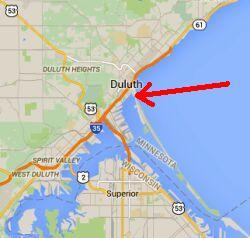
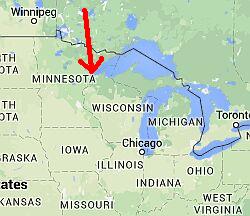
This page is part of the Websites of Wim Kusee